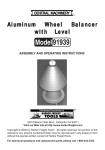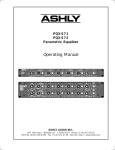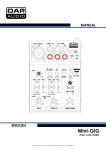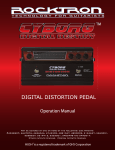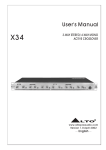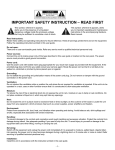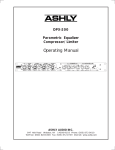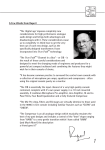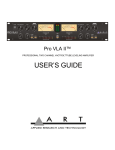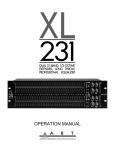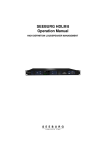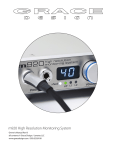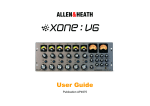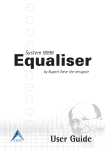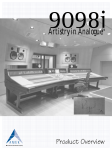Download C:\DMCL User\DMCL User Guide V2.0 English.vp
Transcript
TM ure ath Notes A Few Words from Rupert “The ‘digital age’ imposes completely new considerations for high performance analogue audio design and brings both advantages and disadvantages with it. These considerations cause us to completely re-think how to get the very best out of each new design, such as the specifically designed transformers I have TM incorporated into Pure Path technology. “The Pure Path “Dual Mic Amp Compressor/Limiter” - or DMCL - is the result of these careful considerations and designed to meet the changing needs of engineers and producers for a powerful yet compact outboard unit combining the features they might wish for in their console of choice. TM The DMCL comprises of two identical, closely matched Microphone and Line amplifiers followed by a high resolution Compressor-Limiter with pre/post High and Low Pass Filters. The Microphone Amplifier makes use of “TLA” techniques which provide many of the advantages of a transformer without the penalty of weight and cost. In common with my previous designs for the 9098i Console and SYSTEM 9098 outboard equipment, it features very low noise even at mid gain settings and can accept a full + 26 dBu input signal at unity gain. Because of the increasing use of outboard equipment in the Control Room, I have added a balanced “INSTRUMENT” input to each of the Microphone Amplifiers. These are accessible by a ¼ stereo jack on the front panel and have a very high input impedance, 2.2 Megohms. “The Compressor is an all analogue design which musically emulates the best of my past designs and includes a control of the “knee” shape ranging from “HARD” to a very gentle transition which I have called “&MM” (and Much More!) the description a friend gave it!” 28 1 TM ure ath Notes © 2002 Harman International Industries Ltd. All rights reserved. Parts of the design of this product may be protected by worldwide patents. AMEK is a trading division of Harman International Industries Ltd. Information contained in this manual is subject to change without notice and does not represent a commitment on the part of the vendor. AMEK shall not be liable for any loss or damage whatsoever arising from the use of information or any error contained in this manual or through any mis-operation or fault in hardware or software contained in the product. No part of this manual may be reproduced, stored in a retrieval system, transmitted in any form or by any means, electronic, electrical, mechanical, optical, chemical, including photocopying and recording, for any purpose whatsoever without the express written permission of AMEK. It is recommended that all maintenance and service on the product should be carried out by AMEK or its authorised agents. AMEK cannot accept any liability whatsoever for any loss or damage caused by service, maintenance or repair by unauthorised personnel. PART No: MANDMCL Issue 2 Harman International Industries Ltd Langley House Third Avenue Trafford Park Manchester M17 1FG United Kingdom Tel: +44 (0) 161 868 2400 Fax: +44 (0) 161 873 8010 E-mail: [email protected] Web: www.amek.com 2 27 TM ure ath Contents Channel Crosstalk Digital Output Specifications Unity gain path, level +20dBu. All digital measurements are made Unused inputs terminated with 150 ohm with a sine wave signal of 997Hz A-B -120dBu @ 1kHz -100dBu @ 15kHz B-A -120dBu @ 1kHz -100dBu @ 15kHz Table of Contents @ 48kHz internal sampling A Few Words from Rupert . . . . . . . . . 1 frequency, unless otherwise stated. Unpacking . . . . . . . . . . . . . . . . . . 4 0dB F.S.D. = +26dBu Frequency Response Important Safety Instructions . . . . . . . 5 Main Output Unity gain, sampling frequency frequency - 48kHz 10Hz to 23kHz (-3dBFs) Maximum Output Level Unity gain, sampling frequency 96kHz 10Hz to 45kHz (-3dBFs) Unity gain +26dBu Audio Connections. . . . . . . . . . . . . 10 Sampling Frequency Range Connections . . . . . . . . . . . . . . 10 Output Impedance @ 1kHz <100 ohms Internal Sync - 44.1kHz, 48kHz, 88.2kHz, 96kHz Compressor Link. . . . . . . . . . . . 11 Harmonic Distortion External Sync - 30kHz to 96kHz Input/Output level at +20dBu Word Length 24Bit Dynamic Range 112dB THD measured @ 1kHz 10k ohms load 0.0007% 600 ohms load 0.0007% Output Balance Unity gain @1kHz Installation . . . . . . . . . . . . . . . . . 9 THD measured @ 997Hz Operational Guide . . . . . . . . . . . . . 11 Mic Input . . . . . . . . . . . . . . . 12 Harmonic Distortion Instrument Input . . . . . . . . . . . 13 Input level at +20dBu (-6dB F.S.D.) -40dBu Signal Paths . . . . . . . . . . . . . . 11 <0.001% Block Diagram . . . . . . . . . . . . . . . 14 Power Consumption Channel Status Analogue only version 20W max. With digital option fitted 30W max. The unit applies the following channel status settings: Line Input . . . . . . . . . . . . . . . 16 Professional Format, Filters . . . . . . . . . . . . . . . . . 18 Linear PCM, No Emphasis, Two Channel Mode, Byte 0 (bits 6&7) and Byte 4 (bits 3-6) are programmed according to the relevent sampling frequency. Note: The channel status settings in the AES data stream ALWAYS follow the switch setting of the unit, even if the unit is “synced” to an external source. 26 Operational Guide . . . . . . . . . . . . . 16 Compressor . . . . . . . . . . . . . . 20 Digital Output (Option) . . . . . . . . 22 Key / Insert Option . . . . . . . . . . 23 Specifications . . . . . . . . . . . . . . . 24 Warranty . . . . . . . . . . . . . . . . . . 29 3 TM ure ath Unpacking Specifications Check List The following items are included with the product. Please retain all packaging materials until all expected items are accounted for and found to be operating Filters Compressor Cont. High Pass Filter Distortion Setting as for Noise above Frequency Range (-3dB points) Packet containing: 4 off M6 mounting screws 4 off plastic washers Carton Moulded IEC mains lead Unity gain 20Hz to 300Hz Slope 18 or 24dB per octave -99dBu Harmonic Distortion 0.02% Frequency Response 10Hz to 200kHz (-3dBu) Noise DIN Input/Output level at +20dBu THD measured @ 1kHz 0.02% Unity gain Compressor Key Insert Send Noise DIN Measured at the output , unity gain Input signal +10dBu @ 1kHz Measured at the output, gain unity. -93dBu Typically 0.0007% Distortion Output signal +20dBu @ 1kHz Low Pass Filter 0.0007% Output Balance Frequency Range (-3dB points) Unity gain @1kHz Unity gain 2.5kHz to 28 kHz Slope 12 or 18dB per octave - 40dBu Maximum Output Level Noise DIN Measured at the output , unity gain Unity gain +26dBu Output Impedance -98dBu @ 1kHz <75 ohms Harmonic Distortion Protective foam materials Dual Mic Amp Compressor/Limiter Input/Output level at +20dBu THD measured @ 1kHz Frequency Response Compressor Gain range Quality Certificate User Guide Protective foam materials Procedure 1. Remove all loose items from the packaging. 2. Slide the unit (along with the protective foam parts) out of the box. 3. Slide the protective foam parts away from the unit. Compressor Key Insert Return Typically 0.0007% Noise DIN Measured at the output, gain unity. -105dBu -10dB to +24dB Distortion Threshold range -40dB to +22dB Ratio range 1:1 to 40:1 Attack range 0.3ms to 300ms Release range 0.1Sec to 10Sec Output signal +20dBu @ 1kHz 10Hz to 200kHz (-3dBu) 0.0007% Output Balance Unity gain @1kHz - 60dBu Maximum Output Level Unity gain Frequency Response Unity gain 10Hz to 200kHz (-3dBu) +26dBu Output Impedance @ 1kHz >10k ohms Noise DIN Measured at the output, gain unity. Threshold @ 0dBu. 4 -92dBu 25 TM ure ath Specifications Important Safety Instructions / Instructions de Sécurité Importances Mic Input Frequency Response Unity gain setting, 150 ohm source Line Input Cont. 10Hz to 200kHz (-3dBu) Harmonic Distortion Gain Range Unity gain setting, input/output level +20dBu Unity to +66dB, in 6dB steps, and +/-12dB variable trim THD measured @ 1kHz Input Impedance T.L.A. Input Impedance Maximum Input Level >5,000 ohms +26dBu -60dBu Instrument Input Equivalent Input Noise DIN (Bandwidth 22Hz-22kHz) (Measurement with gain at 66dB) Balanced and floating transformer Input @ unity gain Input Balance @1kHz 0.0007% Frequency Response -128dBu Unity gain setting, 150 ohm source 10Hz to 200kHz (-3dB) -127dBu Gain Range Unity to +66dB Input terminated with 150 ohms (Measured with gain at 36dB) Input terminated with 150 ohms (Measured at unity gain) -100dBu Input terminated with 150 ohms Equivalent Input Noise DIN (Bandwidth 22Hz-22kHz) Harmonic Distortion (Measurement with gain at 66dB) Unity gain setting Input terminated with 150 ohms Input/Output level +20dBu THD measured @ 1kHz (Measured at unity gain) 0.0007% Maximum Input Level T.L.A. @ Unity gain -109dBu -100dBu Input terminated with 150 ohms Input Balance +26dBu @1kHz -60dBu Harmonic Distortion Line Input Unity gain setting Input/Output level +20dBu Frequency Response THD measured @ 1kHz Unity Gain 10Hz to 200kHz (-3dB) Gain Range -12dB to +12dB 0.0007% Cautions Warnings and Notes Please read this manual carefully before connecting this apparatus to the mains for the first time! For your own safety and to avoid invalidation of warranty, all text marked with these Safety Symbols should be read carefully! Please keep this information! Cautions Hazards or unsafe practices which could result in severe personal injury or death. Avis Dangers ou pratiques dangereuses pouvant résulter en des blessures graves ou causant la mort. Warnings Hazards or unsafe practices which could result in minor personal injury or product or property damage. Avertissements Dangers ou pratiques dangereuses pouvant résulter en blessures personnelles mineures légères ou en dommages à la propriété. Notes Contain inportant information and useful tips on the operation of your equipment. Notes Contiennent l’information de inportant et les pointes utiles sur l’opération de votre équipement. Maximum Input Level Input Impedance Bridging Input Impedance >10,000 ohms -60dBu Overall Noise DIN Measured at the output 24 +26dBu Input Impedance Input Balance Unity gain @1kHz Unity gain Input Impedance >2M0 ohms Earthing / Terre This apparatus MUST be earthed. Under no circumstances should the mains earth be disconnected from the mains lead. Cet appareil DOIT être mis à la terre. La mise à terre ne doit pas être débranchée du terminal principal sous acune circonstance. -102dBu 5 TM ure ath Important Safety Instructions / Instructions de Sécurité Importances Mains Cable / Cable de Secteur The supplied IEC mains cable must be terminated correctly to the AC mains supply before use. Use only an approved AC plug or power distribution device. The Green/Yellow core in the mains cable is a safety ground and must be connected at all times! The three cores are colour coded as follows: Safety Earth Live Neutral = = = Green/Yellow (Green/Yellow USA) Brown (White USA) Blue (Black USA) Le cable de secteur IEC fourni doit être correctement au cable d'alimentation avant l'utilisation. Utiliser seulement une prise de courant conforme. Le cable vert/jaune à l'intérieur du cable d'alimentation est la sécurité terre et doit être toujours connecté! Les 3 cables à l'intérieur du cable d'alimentation sont de couleurs suivantes: Prise de Terre Phase Neutre = = = Vert/Jaune (Vert/Jaune USA) Marron (Blanc USA) Bleu (Noire USA) Changing the Fuse / Changer le Fusible To avoid the risk of fire replace only with same value and type of fuse as marked on the unit. Before changing the fuse, always switch off the unit and remove the AC power cable! Using a flat blade screwdriver, press the fuse cap inwards gently and twist anti-clockwise to release the cap. Fit the new fuse to the cap and replace it in the fuseholder by reversing the procedure. Afin d'éviter un risque de feu, remplacer seulement avec fusible de la même valeur et type tel qu'indiqué sur l'appareil, 1A (100-230V T). Les fusibles sont de type IEC 20mm protection-surtension (pour fusibles). Operational Guide Word Clock Output The Word Clock output jack is a standard 75 Ohm BNC type connector that outputs word clock for slaving and synchronising other units. Digital Outputs The Digital signal is simultaneously applied to the three output connectors, providing the following formats. Phono - S/PDIF (The Sony Philips Digital Interface Format). Opto - TOSLINK . XLR. - AES-3 Note: The channel status settings in the AES data stream ALWAYS follow the switch setting of the unit, even if the unit is “synced” to an external source. Key / Insert Option - (Internal switch) The Key/Insert internal option switches (S37 CHA, S38 CHB) allows the Compressor Key inserts to be used as Main signal path inserts when selected. In the Insert mode, the insert point is always pre-compressor. The PRE-FLT switch moves the insert with the compressor pre or post Filters. The KEY switch acts as the insert in/out switch. The Insert Send is always active, and can be used as a Direct output pre or post Filters. Insert Send and Return are electronically balanced and can operate up to +26dBu. 6 23 TM ure ath Operational Guide Important Safety Instructions / Instructions de Sécurité Importances Avant de changer le fusible, éteindre l'appareil et enlever la prise d'alimentation! Utiliser un tourne vis à tête plate, appuyer sur le capuchon du fusible doucement vers l’interieur et tourner dans le sens contaire des aiguilles d’une montre pour dégager le capuchon. Mettre le nouveau fusible dans le capuchon et remetre en place en faisant la procédure inverse. Digital Output (Option) Clock In The Clock in jack is a standard 75 Ohm BNC connector that connects to an â external sync source, either Word Clock or Pro Tools Superclock. Int / Ext - Wclk / Sclk Int / Ext switches between internal or external sync modes. When the unit is set to external the Wclk / Sclk switch can be used to â switch between Word Clock or Pro Tools Superclock as the sync source. Sampling Rates Internal sampling rates of 44.1kHz, 48kHz, 88.2kHz and 96kHz can be selected by the appropriate switches located on the rear panel. 100V/230V Operation / Fonctionnement This apparatus does not require any operating voltage adjustment. Cet appareil n’exige pas l’ajustement de tension qui opérant. Servicing / Services The servicing instructions in this manual are for use by qualified personnel only. To reduce the risk of electric shock, do not perform any servicing other than that contained in the operating instructions unless you are qualified to do so. Refer all servicing to qualified service personnel. Les instructions de services contenues dans ce manuel sont pour utilisation seulement par des professionels. Pour réduire le risque de choc électrique, ne tenez aucune opération de service sauf celles contenues dans le manuel d’opération a moins d’être qualifié pour le faire. Référez toute réparation à un agent de service professionel. CAUTION Digital Output Leds The 44.1kHz, 48kHz, 88.2kHz and 96kHz Leds indicate which internal sampling rate has been selected. RISK OF ELECTRIC SHOCK DO NOT OPEN ! AVIS: RISQUE DE CHOC ELECTRIQUE NE PAS OUVRIR The Lock Led, when illuminated, indicates a stable lock condition. The External led, when illuminated, indicates an external sync source has been selected. 22 7 TM ure ath WARNING - For your own safety and to avoid invalidation of the warranty, please read this section carefully. • Do not place the apparatus on an unstable surface. • Do not insert objects through any apertures. • Do not use this apparatus near water. • Unplug the unit before cleaning. Clean only with a damp cloth. • Do not block any of the ventilation openings. Install in accordance with the manufacturer's instructions. • Do not install near any heat sources such as radiators, heat registers, stoves or other apparatus including amplifiers or power supplies that produce heat. • Do not defeat the safety purpose of the polarised or grounding-type plug. A polarised plug has two blades with one wider than the other. A grounding-type plug has two blades and a third grounding prong. The wider blade or the third prong are provided for your safety. When the plug provided does not fit into your outlet, consult an electrician for replacement of the obsolete outlet. • Protect the power cord from being walked on or pinched particularly at plugs, convenience receptacles and the point where they exit from the apparatus. • Avoid using mains outlets on the same circuits as air control systems or other equipment that regularly switches on and off. • Only use attachments /accessories specified by the manufacturer. • Unplug this apparatus during lightning storms or when unused for long periods of time. • Refer all servicing to qualified service personnel. Servicing is required when the apparatus has been damaged in any way, such as the power supply cord or plug is damaged, liquid has been spilled or objects have fallen into the apparatus, the apparatus has been exposed to rain or moisture, the apparatus does not operate normally or the apparatus has been dropped. Unplug the unit under these circumstances. • Adjust only those controls that are covered by the operating instructions. • Use only the mains lead provided with the equipment . Other leads may not have sufficient current rating. • Do not operate this unit with the cover removed. 8 Operational Guide Key The Key switch enables the compressor insert. Compressor Link When enabled, identical gain reduction can take place when two or more units are linked together. The applied gain reduction is derived from whichever path has the greatest signal. If you want identical compression using two or more units the controls on each separate unit have to be set up in a similar manner. If you wish to use &MM in a link situation, all the &MM buttons have to be enabled on the other units involved in the link, otherwise identical gain reduction will be lost. Compressor A link switch, when activated, allows Compressor A to be linked to Compressor B. This enables it , for example, to be used as a stereo pair, ie: track each other. Compressor B link switch activates the Channel B link jack socket (located on the rear panel) to allow linking to other units. Compressor A link jack socket is permanently active, ready to receive a signal from another pure path unit. Pre Filter The Compressors are normally post filter, the PRE FLT switch allows the Compressors to be pre filters. Gain Reduction Meter If the signal exceeds the compression threshold, the amount of gain reduction is displayed. 21 TM ure ath Operational Guide Installation Location This product is designed and screened to minimise internal electromagnetic emissions and provide immunity to external electromagnetic fields. Compressor Threshold Adjusts the level setting at which gain reduction begins to occur. The range is –40dB to +22dB. Attack Changes the time over which compression begins to occur. The range is 0.3 to 300mS. Release Determines the time taken for the gain reduction to stop being applied. The range is 0.1 to 10 Seconds. Ratio Changes the severity of the gain reduction once the signal exceeds the threshold setting. The range is 1:1 (no compression) to 40:1 (limiting). &MM (and Much More!) Selects a different shape to the compression curve which musically emulates the best of my past designs. Output Gain Using compression causes the output signal level to be reduced. This drop in the output level is therefore compensated for using the output gain control. The gain range is -10dB to +24dB. To reduce the risk of performance degradation due to external interference, do not site this unit close to sources of strong magnetic fields such as power supplies, power amplifiers, loudspeakers etc. Rack Mounting This product is designed to be rack mounted using the screws and washers supplied to help preserve the finish of the facia panel. The facia graphic layer is under-surface printed to provide a robust hard wearing surface designed to last the life of the product in virtually any operating environment. It is recommended that additional rear or side supports are used in conjunction with the facia panel fixings, particularly when the unit is mounted in a flight-case or vehicle where vibration and transit shocks can be expected. Powering up and Clicks Clicks may be heard from in/out switches when the product is powered up, these will dissipate after approximately 10 minutes. This is perfectly normal. Cleaning Unplug the unit before cleaning. The product should be cleaned with a soft brush around the controls. If the facia becomes dirty, use a damp cloth with a little household soap to remove the dirt. DO NOT use solvent cleaners under any circumstances or the facia may be permanently damaged and warranty invalidated! In Switches the Compressor into the signal path. 20 9 TM ure ath Connections Audio Connections Inputs The Mic input is electronically balanced via a standard 3 pin female XLR connector and employs Rupert Neve’s TLA (transformer like amplifier). The Line input uses a transformer balanced arrangement via a female XLR. The Instrument input is electronically balanced via a standard ¼ inch Jack Socket located on the front panel. Outputs The outputs are transformer balanced via standard 3 pin XLR male connectors. Inserts The Send is electronically balanced via a ¼ jack. This is half normalled to the compressor return. The return is electronically balanced via a ¼ inch jack. The inserts also allow you to input an external device into the compressor side chain. Wiring Conventions The audio connectors are wired as follows: XLR: Pin 1 = Screen; Pin 2 = Hot (+); Pin 3 = Cold (-) ¼ Jack: Sleeve = Screen; Tip = Hot (+); Ring = Cold (-) 10 Operational Guide High Pass The High Pass filter operates over a frequency range of 20Hz to 300Hz with a switchable slope of 18dB or 24dB/Octave allowing the removal of unwanted low frequency noise components such as rumble and hum. High Pass Filters Response 10.0 0.0 -10.0 -20.0 -30.0 -40.0 -50.0 10 Low Pass The Low Pass filter operates over a frequency range of 2.5kHz to 28kHz with a switchable slope of 12dB or 18dB/Octave. The extended range allows the filter to remove unwanted harmonic distortion in the conventional audio band caused by audio components in the inaudible upper frequency bands. 100 1k 10k 100k 10k 100k Low Pass Filters Response 10.0 0.0 -10.0 -20.0 -30.0 -40.0 -50.0 10 100 1k 19 TM ure ath Operational Guide Operational Guide Compressor Link The Compressor sections of two or more units may be linked via the Link A and Link B connections. When connected, identical gain reduction can take place across the connected units. The applied gain reduction is derived from whichever path has the greatest signal. Filters Two attenuation slopes are provided for the High Pass variable frequency filter, giving a choice of 18 or 24 dB/Octave. Similarly two attenuation slopes are provided for the variable frequency Low Pass filter, with a choice of 12 or 18 dB/Octave. The units are linked together using a mono or stereo ¼ inch jack lead via the connector on the rear panel. For more than two units, create a daisy-chain lead with all the tip contacts wired together and with all the sleeve contacts wired together (the ring contact is not used). See also section entitled “Compressor Link” for operation of this facility. A steep filter at the low frequencies can be extremely useful to remove building rumble or excessive low frequency ambience without affecting the musical spectrum. At the high frequencies the 18 dB/Octave slope can effectively remove interference or help shape the signal for digital recording, but the 12 dB/Octave slope is more useful as a shaping tool to adjust musical harmonic content. Signal Paths There are two audio signal paths within DMCL, Chan A and Chan B. The side-chains are sourced from the relevant selected inputs. Filters In Each filter can be switched in and out independently or together and are only active when their relevant switches are operated. These switches operate irrespective of the audio path they are resident in: Main Signal or Side-Chain. Selecting "Side-Chain" allows filter settings to be inserted into the Compressor side-chain allowing gain reduction to be frequency dependent. LF cut can be applied to the side-chain to prevent a bass line “pumping” the overall signal level. Side-chain Switch Switches the High Pass and Low Pass filters into the side-chain path. 18 11 TM ure ath Operational Guide Operational Guide Level Meter Each path is equipped with its own level meter, which can display the input or output levels as selected by the Meter & O/L Source switch. The meter is calibrated to read 0 for levels of +4dB. Mic Input The microphone input circuit is a T.L.A. (Transformer-LikeAmplifier). It behaves like a transformer in that if a signal is applied to one input leg only, no (or very little) output is the result. A common mode input coil rejects common mode signals and acts as a Low Pass Filter for differential inputs. O/L LEDs Mic Path Freq Response There are two overload LEDs monitoring signal levels on the DMCL. All LEDs are set to illuminate 4dB before clipping. The O/L LEDs are sourced from either post the input amplifiers or pre the output driver. 10.0 8.0 6.0 4.0 2.0 -0.0 -2.0 -4.0 -6.0 -8.0 -10.0 10 100 1k 10k 100k 200k A high quality rotary switch provides a gain range from 0dB (unity) to +66dB in 6dB steps. Mic gain trim is continuously variable ±12dB. The mic input impedance is 5k0 ohms thus producing extremely low loss from a 150 or 200 ohm microphone. At unity gain, the "microphone" amplifier can handle a balanced input signal of more than + 26dBu without an attenuator pad (this is a unique feature amongst "microphone" amplifiers), it could therefore double as an additional high performance Line Input. 12 17 TM ure ath Operational Guide Operational Guide Instrument Input The Instrument input is a secondary input to the Mic amp. It utilises a high impedance input amplifier, 2.2 Megohms. The Mic rotary gain and Mic trim provide gain control over the Instrument input. The gain range remains the same as the Mic input. Line Input The Line input is a 10k0 ohm (bridging) balanced and floating transformer design which provides uncompromising isolation and protection against ground currents and any unwanted signals. Line Path Freq Response To activate the Instrument input, the Mic input and the Instrument buttons have to be selected. 10.0 8.0 6.0 4.0 2.0 Note: The LINE button overrides the Mic or Instrument inputs 0.0 -2.0 -4.0 -6.0 100 1k 10k 100k 200k Unlike traditional transformers the frequency response and distortion are independent of the source impedance of the preceding equipment. Full low frequency performance is maintained even with input levels higher than +20dBu. Gain is provided on a variable control covering a ±12dB range. The Line Input features a new high performance transformer with exceptional low frequency performance… as with any genuine transformer input, this Line Input may be used with either balanced or unbalanced sources without having to allow for change of gain due to grounding one leg of a so-called ‘electronically balanced' circuit. 16 8.0 6.0 4.0 2.0 150 ohm source 0.0 1k ohm -2.0 -4.0 -6.0 -8.0 -10.0 10 Instrument Input Freq Response 10.0 The Instrument input is protected from the 48V and can be used balanced or unbalanced. 5k ohm source -8.0 -10.0 10 100 1k 10k 100k 200k Keep the instrument lead short to avoid high frequency loss especially with high impedance guitar pickups. Phantom Power The 48V switch applies 48V phantom power to the Mic input XLR. Note: Under no circumstances press the 48V switch if an unbalanced source is connected to the XLR. Phase Switch The Ø (phase) switch allows phase inversion of the selected input. The switch should normally be released. 13 14 Mic ‘A’ Line ‘A’ Instrument ‘A’ +48V Line ‘B’ Instrument ‘B’ Mic ‘B’ Block Diagram +48V Send Return/In Balanced Driver Send Return/In Key Insert ‘B’ T.L.A. (0dB to +66dB) Instrument Phantom Power Balanced Driver Key Insert ‘B’ T.L.A. (0dB to +66dB) Instrument Phantom Power Line Line Key Phase Key Phase Mic Trim/ Line Gain ±12dB Mic Trim/ Line Gain ±12dB HPF In HPF 20-300Hz &MM Internal switch Key Ins Rectifier &MM Compressor/Limiter In Compressor/Limiter Post Filters Compressor/Limiter Pre Filters HPF In HPF 20-300Hz Compressor/Limiter In Rectifier Filters to S/C Internal switch Key Ins Compressor/Limiter Post Filters Compressor/Limiter Pre Filters Filters to S/C Compressor/ Limiter Gain Reduction Meter LPF In Compressor/ Limiter Gain Reduction Meter LPF In LPF 2.5-28kHz LPF 2.5-28kHz Link Link A-B Compressor Link ‘B’ Compressor Link ‘A’ Meter and O/LSource I/P O/P Output ‘B’ Out Clock O/L LED Level Meter In Digital Output O/L LED Level Meter Output ‘A’ S/Pdif Opto AES ure ath TM 15














